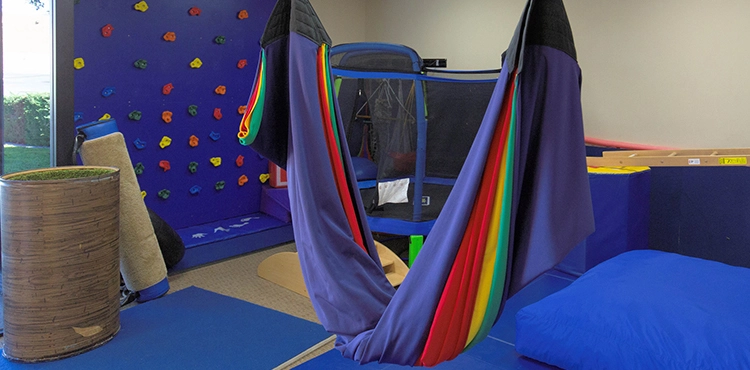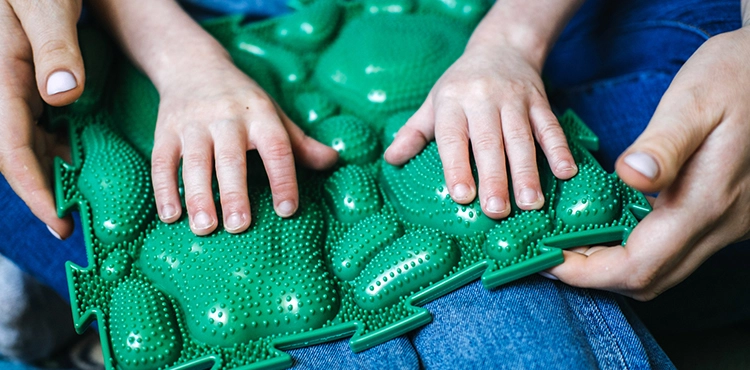How to Create a Sensory Room for Autistic Kids
Updated on March 11, 2024
A sensory room for autistic kids is a designated room or space in your home that is a safe place for your child to go to decompress or calm their senses when they are experiencing an overload of overwhelming feelings. It is an environment that contains sensory-friendly objects, which have a calming effect on the child. Because each autistic child’s sensitivities are unique to them, sensory rooms will encompass different items on an individual basis, but the idea behind the room is the same for everyone.
What Are Sensory Triggers?
Before we jump into the logistics of creating a sensory room for autistic kids, let’s first look at what sensory triggers are and why it’s important to understand your child’s specific sensory triggers.
Sensory triggers are certain sounds, sights, smells, textures, and tastes that are overwhelming for your child. For example, bright lights and loud noises can trigger feelings of discomfort, causing them to get upset easily. Food textures and scratchy clothing materials are also types of sensory triggers for kids.
Many times, autism and sensory issues go together, which is why understanding your child’s sensory triggers are crucial. There are two forms of sensory processing issues – hypersensitivity (oversensitivity) and hyposensitivity (under-sensitivity). Oversensitive children avoid the situations that cause them anxiety, such as loud noises and bright lights. Whereas, kids who are under-sensitive, seek out sensory input, such as needing more physical contact and touching. And many times, children have a mixture of both over and under-sensitivity.
Determining where your child falls on the sensitivity scale and what triggers they react to is central to creating a sensory room for your autistic son or daughter.
Why Do Autistic Kids Need Sensory Rooms?
You might be wondering, “Why does my autistic child need a sensory room?” And it’s a valid question. While children who do not have sensory issues or autism are fine simply going to their room when they are having a rough time, children with autism might not process that the bedroom is also a place for them to feel calm. To them, the bedroom is where they go to sleep, and they might not be capable of separating the two issues.
But on the other hand, a designated room that has ONE purpose of helping them feel calmer or de-escalate will send a definite message. And they will learn to understand that it is their tool for self-calming or escaping sensory overload. It’s important not to confuse your child and send a clear message of the purpose of the sensory room – to give them a specific place that provides a sanctuary for them to escape sensory overload or to calm themselves down.

What are the Benefits of a Sensory Room?
There are a variety of benefits of adding a sensory room to your home, many of which will be specific and unique to your child’s needs. Here are some of the key benefits of adding a sensory room to your home:
- Encouragement – A sensory room can positively encourage your child to take some time to calm or redirect themselves when they are feeling overwhelmed or overstimulated. It’s their “safe space” to go when they need that time alone.
- Re-focusing – Time in the sensory room helps autistic children re-focus on positive aspects of their lives instead of what was triggering them.
- Appropriate Sensory Stimulation – Because the sensory room will only have items that help soothe or calm your child, they will have access to sensory stimulation that their bodies need. It also teaches them what sensories help them when they are faced with overwhelming stimulation.
- Enhance Learning – You can also add occupational therapy and learning moments inside the sensory room, engaging different areas of the brain, which will lead to improved information retention and positive reinforcement.
- Improve Motor Skills – Items you place inside the sensory room are strategically placed for improving fine and gross motor skills as well as soothing for your child.
- Self-regulation – By providing a sense of calm and comfort, another benefit of a sensory room is that it helps children learn how to self-regulate their behaviors.
- Safe place – Simply having a safe place to go inside the house when your child is feeling like the world is spinning around him is a huge benefit of having a sensory room – for him and the rest of the family as well.
What to Consider Before Creating a Sensory Room
Before jumping head-first into creating a sensory room at home, there are four key questions you should ask yourself:
- What is my budget? You definitely need to have this in mind before you begin. Your budget will determine the type of sensory room you create and what you add inside the room. And even if your budget is on the lower side, don’t let that deter you – you can make a great sensory room for your child for under a hundred dollars.
- What is our purpose for adding a sensory room? Your purpose will determine exactly what type of room you’ll create. Is it to simply provide a place for your child to go when they feel overwhelmed? Or do you also want it to be an educational or therapeutic space as well? This is what you need to consider before beginning.
- What sensory experience will you add to the sensory room? Another great question that you need to ask yourself is what you’ll place inside the room. Answering this question will be 100% unique to your child’s needs and what will be most beneficial to them. You might want to consult with your child’s occupational therapist or teacher to help determine what sensory items work best.
- Where will your sensory room be located in your home? Sensory rooms can range from portioning off a small corner of an existing room to making it an entire room of itself. Some parents add a child’s tent as the sensory room, and some take an extra room. Wherever your sensory room is located, you’ll want to make sure it’s specified for just that purpose.
What Items to Place in Your Sensory Room
Now that you’ve properly addressed your why and how we can jump into what to add inside your sensory room to meet the needs of your child. There are a few different categories that you want to focus on, choosing items that will not only fall into those categories but will match your budget and appeal to your child. Each category supplements various aspects of the overall sensory experience.
Vestibular Items to Add to Your Sensory Room
The vestibular system relates to the structures within the inner ear that creates our sense of balance or movement. A healthy vestibular system helps all other sensory systems, which is why it’s important to add vestibular items to your sensory room – to improve balance and a sense of movement confidence.
The most popular vestibular item to add is a swing. Swings are useful sensory tools because they create a soothing and repetitive motion. Cloth swings that essentially look and act like hammocks also add a sense of being cocooned, making a child feel safe. Swings also help build up core strength and, of course, vestibular balance.
If you are designating an entire room for your sensory area, therapeutic swings that are hung from the ceiling are fantastic. But if you want to cut down on your budget or have a smaller space to work with, rocking horses, glider rockers, and small hammocks are great alternatives. Other vestibular items include small trampolines, spooner boards, balance pods, moon shoes, foam pogo sticks, gym mats, and exercise and hopper balls.
Proprioceptive Items to Add to Your Sensory Room
Proprioceptive input relates to the sensory orientation of the body in space – essentially how our joints and muscles tell us about our body movements. Many autistic children feel a disconnect from their bodies and need physical sensory inputs to feel centered.
Weighted vests and blankets are fantastic proprioceptive items to add to your sensory room to give them that extra physical input they crave. Sensory tunnels and IKEA tunnels also provide proprioceptive input.
Some other proprioceptive items you can add to your room include stretchy bands, fidget toys, body socks and body pillows, a bean bag chair, or even a crash pad.

Visual Items to Add to Your Sensory Room
Many children on the autism spectrum are sensitive to bright lights or harsh lighting, so the visual input in your sensory room is an important aspect to consider. The room should be visually comforting – avoid fluorescent and flashing lights.
Adjustive lighting options are the best way to add a relaxing glow to your sensory space. Some lighting options that will provide your child with the visual stimulation without the overwhelming brightness can include lava lamps, bubble tubes, holiday or string lights, battery-powered candles, and even a sky cosmos lighting machine.
Aural Items to Add to Your Sensory Room
Auditory stimulation correlates to the sounds and noises we hear. Because many autistic children are sensitive to loud noises, adding aural items to your sensory room is another key area to focus on.
A popular aural item to place in a sensory room is noise-blocking headphones to help regulate noise sensitivity. Noise-blocking headphones are different from noise-canceling headphones as they reduce the sounds and are typically less expensive. If your child has significant issues with noise, then noise-canceling headphones might be a better investment.
Other aural items to add are white noise or sound machines, soothing nature music, chimes, soothing audiobooks, earmuffs, and even musical instruments.
Olfactory Items to Add to Your Sensory Room
Olfactory relates to the sense of smell, and this is another sensory response that autistic children have strong responses to. Strong smells can be very overwhelming for those on the autism spectrum, while other smells have a calming and relaxing reaction.
Aromatherapy techniques can be a nice addition to your child’s sensory room. Scents such as lavender have calming effects, so adding touches (not too much) of lavender can be warming. You can also add items such as scented dough or scented stickers to play with. And scented bubbles are an extra boost to the oral sensory experience.
Completing Your Sensory Room
As you can see, it takes a lot of thought and planning to efficiently create a sensory room that complements your child’s needs. But once it’s ready, it will be such a therapeutic experience – for both them and you. Just remember that it is meant to be a safe haven for your child and, therefore, should only contain items that are specific to their needs. And whether you’re creating a sensory room, corner, or space – the benefits will outnumber the costs any day!

